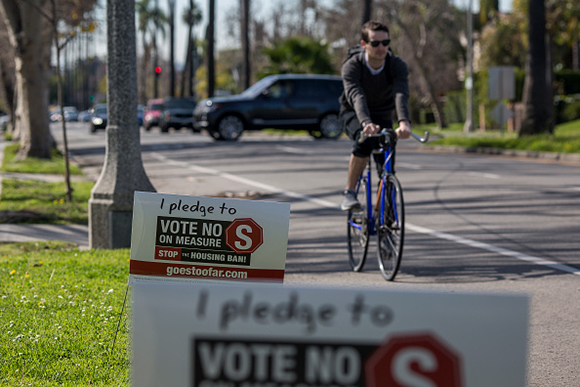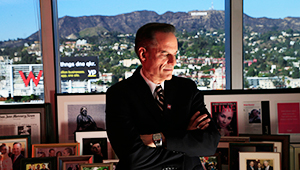Trending
“SHEBANG”: Voters shoot down Measure S

Updated, March 8, 2016, 1:00 p.m.: The results are in, and developers and housing advocates are clinking glasses.
Angelenos voted on Tuesday to quash the controversial Measure S, the initiative which would have imposed a two-year moratorium on nearly all developments in L.A. The mere possibility that the measure would pass had many in the real estate industry in a state of limbo — afraid to make deals that would require entitlements. Its detractors say that by shooting down Measure S in such an emphatic manner –it received only 31.15 percent of votes – voters averted a catastrophe in the housing market.
“I’m unbelievably relieved,” City Council President Herb Wesson told The Real Deal Tuesday night, at the “No on S” campaign’s party at the L.A. Hotel, where there were smiles all around. “I’m optimistic that a lot of the concerns from “Yes on S” will be addressed, but it’s just that they took it too far. The voters rejected Measure S, and they rejected it big.”
The No campaign officially declared victory late Tuesday night, as the party broke out in celebration.
“There’s one thing I say when I’m happy — shebang!” Wesson said to the audience around 11 p.m. The crowd echoed him back — “shebang!” — cheering.
Just after midnight on Wednesday, the Yes campaign conceded.
“This campaign will go down in the record books as one of the most successful campaigns that did not actually win the vote,” said Michael Weinstein, president of the AIDS Healthcare Foundation, which championed Measure S. “We not only exposed corruption but we began a process of reform. We built a citywide movement and we planted the seeds of change. Los Angeles will be a better place to live as a result of the Yes on S campaign.”

Michael Weinstein of the AIDS Healthcare Foundation
Scores of developers, elected officials, and affordable housing advocates alike had voiced strong opposition to Measure S, including Mayor Eric Garcetti and Gov. Jerry Brown.
“Now that a broad coalition of diverse stakeholders have voted down Measure S, the city can continue to develop programs to update our community plans and provide solutions for the city’s homelessness problem,” said Ed Casey, a partner at law firm Alston & Bird. “Those programs will provide the proper balance for development, jobs and the needs of our communities.”
In campaigning for and against the initiative, organizers spent a total of more than $13 million, ethics filings show.
Nearly 100 percent of funding for the Yes campaign came from the AIDS Healthcare Foundation, which poured about $5 million into the campaign. The opposing side raised $8 million from developers, housing advocates, and labor unions. While Yes invested in billboards and mailers, the No camp focused on canvassing voters.
“The first thing we tell people when we knock on their doors is that Measure S will raise their rents,” a field organizer told TRD.
Both sides dealt in lofty – and, at times, heavy-handed – rhetoric, though critics of Measure S say the campaign often misrepresented itself in ads.
Yes on S had mailers, for instance, claiming the measure would “house our vets,” despite the fact that the initiative text makes no mention of veteran housing.
Opponents said it would have the opposite effect because the moratorium would have affected all the affordable housing projects, including those for homeless veterans, that need a zone change or general plan amendment.
“With the rejection of Measure S, developers will be able to move forward with projects that are on their drawing boards and plan new projects, which in turn will help ease the city’s housing shortage and boost economic growth and development in Los Angeles,” said Beth Mullen, national director of the affordable housing practice at CohnReznick.
But after an exhausting campaign against the ballot initiative, it won’t be back to business as usual, industry observers say.
“This has been a wake-up call to the city’s elected leaders and planning officials that they need to pay closer attention to L.A.’s general plan and community plans,” said David Waite, a partner at Cox Castle & Nicholson.
Thanks to the dialogue that Measure S evoked, he added, site-specific approvals “may become the exception rather than the norm” in the future, a sentiment that echoed Weinstein’s concession statement.
Urbanists see a bright side: the push by Measure S to update plans could lead to more acknowledgment of how L.A. has changed into an urban environment.
“I believe the city can learn from this exercise – there is an opportunity to refresh the existing city plans to reflect the new urban lifestyle that has become so popular in Los Angeles,” said Dan Gura of architecture firm MVE + Partners. “There is a growing trend and desire for walkable communities that can be fulfilled with less restrictions on development. We can also continue to leverage opportunities to turn old parking lots and abandoned buildings into much-needed housing.”
Even days before the vote, polling and analysis showed a tight margin between the two camps. Some say the measure came close to passing because of L.A. politicians’ failure to address the issues behind it.
While politicians like Garcetti fought Measure S, they were “passive through organized labor’s Measure JJJ, failed to reform CEQA and became obsessed with inconsequential victories like anti-mansionization, which reduces new homes by 5 percent,” said JLL’s Carl Muhlstein.
Measure S, Muhlstein added, reflected “public sentiment about a lack of leadership polarizing our community. Disenfranchised homeowners, below-market renters and environmentalists have rallied to drain the swamp.”




